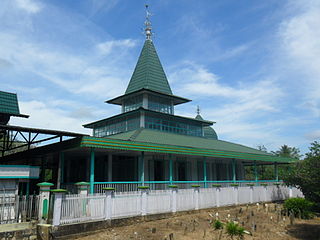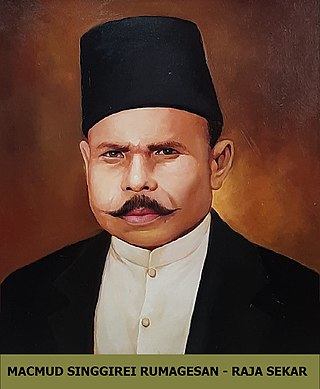
Papua is a province of Indonesia, comprising the northern coast of Western New Guinea together with island groups in Cenderawasih Bay to the west. It roughly follows the borders of Papuan customary region of Tabi Saireri. It is bordered by nation of Papua New Guinea to the east, the Pacific Ocean to the north, Cenderawasih Bay to the west, and the provinces of Central Papua and Highland Papua to the south. The province also shares maritime boundaries with Palau in the Pacific. Following the splitting off of twenty regencies to create the three new provinces of Central Papua, Highland Papua, and South Papua on 30 June 2022, the residual province is divided into eight regencies and one city (kota), the latter being the provincial capital of Jayapura. The province has a large potential in natural resources, such as gold, nickel, petroleum, etc. Papua, along with five other Papuan provinces, has a higher degree of autonomy level compared to other Indonesian provinces.

West Papua, formerly Irian Jaya Barat, is an Indonesian province located in Indonesia Papua. It covers most of the two western peninsulas of the island of New Guinea: the eastern half of the Bird's Head Peninsula and the whole of the Bomberai Peninsula, along with nearby smaller islands. The province is bordered to the north by the Pacific Ocean, to the west by Southwest Papua Province, the Halmahera Sea and the Ceram Sea, to the south by the Banda Sea, and to the east by the province of Central Papua and the Cenderawasih Bay. Manokwari is the province's capital and largest city. With an estimated population of 569,570 in mid-2023, West Papua is the least populous province in Indonesia after South Papua, following the separation off in 2022 of the western half of the Bird's Head Peninsula to create the new province of Southwest Papua, containing 52% of what had been West Papua's population. Its population density is similar to Russia.
Bomberai Peninsula is located in the Western New Guinea region. It is south of the Bird's Head Peninsula, and Bintuni Bay separates the two peninsulas. To the west lies the Sebakor Bay and to the south Kamrau Bay. On the southeast Arguni Bay lies between the peninsula and the Bird's Neck Isthmus.

Fakfak, also known as the District of Fakfak, is a town in West Papua and seat of the Fakfak Regency. It had a population of 12,566 at the 2010 Census, which rose to 18,900 at the 2020 Census. It is served by Fakfak Airport. It is the only town in West Papua with a significant Muslim Indian and Arab Indonesian presence.

Fakfak Regency - formerly spelt "Fak-Fak" - is a regency of West Papua province of Indonesia. It covers an area of 14,320 km2, and had a population of 66,828 at the 2010 Census and 87,894 at the 2020 Census; the official estimate as at mid 2023 was 88,884. The administrative centre is the town of Fakfak.

Wapauwe Old Mosque is a historic mosque in Kaitetu village, located in the Wawane Mountains on the north part of cape Keitetu, Central Maluku, Maluku, Indonesia. Established in 1414, it is the oldest mosque in the Moluccas and possibly the oldest mosque in Indonesia which has been maintained in its original state.

Mapia Atoll, historically known as the Freewill Islands or San David, is an atoll in the Pacific Ocean. It is located in Papua province of Indonesia, approximately 190 kilometers north of the city of Manokwari and 630 kilometers from the islands of Palau. It consists of two main islands, Bras (Berasi) and Pegun (Mapia), the smaller Fanildo, and two minor islands, Bras Kecil and Fanildo Kecil. The islands constitute a part of West Supiori District within Supiori Regency, Papua. The population at the 2020 Census was 199.

The Heritage Mosque of Banua Lawas is an old mosque in Banua Lawas, Tabalong Regency, South Kalimantan. It is one of the oldest mosques in Indonesia. The mosque is also known as Masjid Pasar Arba as there are more pilgrims visiting on Wednesday as it coincides with market day at Banua Lawas. As the oldest mosque in Tabalong regency, in addition to being a place of worship, it is also a milestone and the historical evidence of acceptance of Islam among the Ma'anyan Dayak people in the area.

Rao Rao Mosque is one of the oldest mosques in Indonesia located in Nagari Rao Rao, Tarab River, Tanah Datar Regency, West Sumatra. It is located on the road from Batusangkar bound to Bukittinggi, precisely in Rao Rao. This mosque of Minangkabau and Persian architecture was built in 1908 with a roof made from fibers before being changed to zinc.

Koto Baru Grand Mosque is one of the oldest mosques in Indonesia located in Koto Baru Nagari, Sungai Pagu District, South Solok Regency, West Sumatra.

The Tuo Kayu Jao Mosque is an old mosque in Indonesia that is located in Jorong Kayu Jao, Batang Barus Nagari, Gunung Talang District, Solok Regency, West Sumatra. The existence of the mosque was already recorded in 1599, making it the oldest mosque in Solok Regency and among the oldest surviving mosques in Indonesia.

The Kingdom of Kaimana or Kingdom of Sran is one of the oldest Muslim kingdoms in West Papua, Indonesia. The kingdom was established by Imaga, with the title Rat Sran Nati Pattimuni, traditionally in 1309.

Jami Mosque of Air Tiris is a historical congregational mosque in Riau, Indonesia. The mosque is famously known for being built without nails and considered a cultural heritage of the Riau Province. The mosque is located in Air Tiris Village, Kampar Regency, 50 km from Pekanbaru, the capital of Riau Province. The mosque is officially designated as an Object of Cultural Heritage in 2004 based on the decree no. KM.13/PW.007/MKP/2004 adopted by the Minister of Culture and Tourism, I Gede Ardhika.

Al-Hilal Mosque or Al Hilal Old Mosque of Katangka, better known as Katangka Mosque, is a historical mosque in South Sulawesi, Indonesia. Constructed in 1603 by the first Muslim ruler of the Sultanate of Gowa, Sultan Alauddin, the mosque is considered the oldest mosque in South Sulawesi.

Palopo Old Mosque is a historical mosque in South Sulawesi, Indonesia. Constructed in 1604, the mosque is one of the oldest mosques in the archipelago. The mosque is noted for its unique vernacular architectural style.

Machmud Singgirei Rumagesan was a king of Sekar and pro-integration activist from West Papua. He founded the movement Gerakan Tjendrawasih Revolusioner Irian Barat (GTRIB) in 1953, and became the member of Supreme Advisory Council in 1959. On 10 November 2020, Singgirei Rumagesan was posthumously declared a National Hero of Indonesia for his lifelong efforts to unite West Irian with Indonesia.

Southwest Papua is the 38th province of Indonesia to be created, and was split off from West Papua on 8 December 2022. Despite being named southwest, it is a misnomer and this province is actually located in the northwest edge of Papua. The province comprises the Greater Sorong area which consists of Sorong City, Sorong Regency, South Sorong Regency, Maybrat Regency, Tambrauw Regency, and Raja Ampat Regency. The Bill (RUU) on the Establishment of the Southwest Papua Province was passed into law and therefore it became the 38th province in Indonesia with effect from 8 December 2022.
The Salawati Kingdom is the Islamic kingdom that once stood in Salawati Island, Raja Ampat Regency, Southwest Papua. The center of the Salawati kingdom was located in the Samate village which is currently located in the North Salawati district.
The Kingdom of Sekar, formerly called the Kingdom of Kabituwar, is one of the nine kingdoms that still exist in West Papua Province. The other eight kingdoms are Ati-Ati, Patipi, Rumbati, Fatagar, Arguni, Wertuar, Namatota, and Komisi. This kingdom is located on the Onin Peninsula, Kokas district, Fakfak Regency, West Papua. In the early period, Sekar was a subordinate to the Kingdom of Rumbati, but later it was recognized as its own kingdom.
















